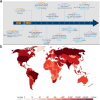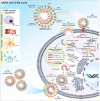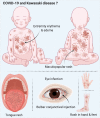The Natural History, Pathobiology, and Clinical Manifestations of SARS-CoV-2 Infections
- PMID: 32696264
- PMCID: PMC7373339
- DOI: 10.1007/s11481-020-09944-5
The Natural History, Pathobiology, and Clinical Manifestations of SARS-CoV-2 Infections
Abstract
Severe acute respiratory syndrome coronavirus 2 (SARS-CoV-2) is the etiological agent of coronavirus disease 2019 (COVID-19). SARS-CoV-2, is a positive-sense single-stranded RNA virus with epithelial cell and respiratory system proclivity. Like its predecessor, SARS-CoV, COVID-19 can lead to life-threatening disease. Due to wide geographic impact affecting an extremely high proportion of the world population it was defined by the World Health Organization as a global public health pandemic. The infection is known to readily spread from person-to-person. This occurs through liquid droplets by cough, sneeze, hand-to-mouth-to-eye contact and through contaminated hard surfaces. Close human proximity accelerates SARS-CoV-2 spread. COVID-19 is a systemic disease that can move beyond the lungs by blood-based dissemination to affect multiple organs. These organs include the kidney, liver, muscles, nervous system, and spleen. The primary cause of SARS-CoV-2 mortality is acute respiratory distress syndrome initiated by epithelial infection and alveolar macrophage activation in the lungs. The early cell-based portal for viral entry is through the angiotensin-converting enzyme 2 receptor. Viral origins are zoonotic with genomic linkages to the bat coronaviruses but without an identifiable intermediate animal reservoir. There are currently few therapeutic options, and while many are being tested, although none are effective in curtailing the death rates. There is no available vaccine yet. Intense global efforts have targeted research into a better understanding of the epidemiology, molecular biology, pharmacology, and pathobiology of SARS-CoV-2. These fields of study will provide the insights directed to curtailing this disease outbreak with intense international impact. Graphical Abstract.
Keywords: Acute respiratory distress syndrome (ARDS); Angiotensin-converting enzyme 2 (ACE-2); Coronavirus disease 2019 (COVID-19); Severe acute respiratory syndrome coronavirus 2 (SARS-CoV-2).
Figures







References
-
- Al Saiegh F, Ghosh R, Leibold A, Avery MB, Schmidt RF, Theofanis T, Mouchtouris N, Philipp L, Peiper SC, Wang ZX, Rincon F, Tjoumakaris SI, Jabbour P, Rosenwasser RH, Gooch MR (2020) Status of SARS-CoV-2 in cerebrospinal fluid of patients with COVID-19 and stroke. J Neurol Neurosurg Psychiatry - PubMed
-
- Archer T (2020) Coronavirus cancellations and reactions in sports. ESPN. https://www.espn.com/espn/story/_/id/28871525/coronavirus-cancellations-...
Publication types
MeSH terms
Grants and funding
- R01 NS036126/NS/NINDS NIH HHS/United States
- R01 MH115860/MH/NIMH NIH HHS/United States
- R01 AI145542/AI/NIAID NIH HHS/United States
- P01 DA028555/DA/NIDA NIH HHS/United States
- P30 MH062261/MH/NIMH NIH HHS/United States
- AG043530/AG/NIA NIH HHS/United States
- T32 NS105594/NS/NINDS NIH HHS/United States
- R56 AI138613/AI/NIAID NIH HHS/United States
- R01 MH121402/MH/NIMH NIH HHS/United States
- NS036126/NS/NINDS NIH HHS/United States
- MH062261/MH/NIMH NIH HHS/United States
- R01 NS034239/NS/NINDS NIH HHS/United States
- NS034249/NS/NINDS NIH HHS/United States
- MH115860/MH/NIMH NIH HHS/United States
- R37 NS036126/NS/NINDS NIH HHS/United States
LinkOut - more resources
Full Text Sources
Other Literature Sources
Miscellaneous

